Calendar
- January 16, 2005 1:00 - 4:00 National Arboretum, “Special Plants and Special Places”, by Don Hyatt
- March 20, 2005 1:00 - 4:00 National Arboretum, “Photographing Flowers and Gardens”, Joshua Taylor
- April 27 - May 1, 2005 ARS Convention - Victoria, British Columbia
- May 7, 2005 Chapter Flower Show, National Arboretum
- May 8 - 9, 2005 Proposed Chapter Field Trip to the Roanoke area
- May 13 - 15, 2005 District Meeting: "Springtime in District Nine", Westminster, MD
“Special Plants and Special Places”
Native Azaleas by Don Hyatt – 01/16/2005
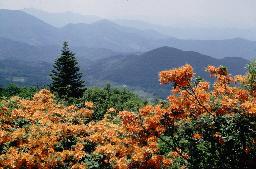 Our next meeting is scheduled for Sunday afternoon, January 16, 2005, from 1:00 to 4:00 PM at the National Arboretum. Chapter president Don Hyatt will be speaking on native azaleas. He will take you on a visual tour to some of his favorite places in the wild where these lovely plants and other wildflowers grow, so come join us for an afternoon of fun, friendship, and lovely flowers. Some of these special plants and places were featured in an article in our fall newsletter.
Our next meeting is scheduled for Sunday afternoon, January 16, 2005, from 1:00 to 4:00 PM at the National Arboretum. Chapter president Don Hyatt will be speaking on native azaleas. He will take you on a visual tour to some of his favorite places in the wild where these lovely plants and other wildflowers grow, so come join us for an afternoon of fun, friendship, and lovely flowers. Some of these special plants and places were featured in an article in our fall newsletter.
Surely one of the most scenic spots anywhere in the world is along the Appalachian Trail near Roan Mountain at the border of North Carolina and Tennessee. On a clear day, the commanding views among the yellow and orange flame azaleas, calendulaceum (pictured), and purple rhododendrons, catawbiense, is breathtaking. Don will show you other rare plants he has found on Wayah Bald and Hooper Bald. He will take you to Gregory Bald in the Smokies to see native azaleas in every color.
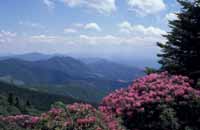 We are considering another Chapter Field Trip to the Roan Mountain and Gregory Bald areas again this June. If you were unable to join us in 2002, consider hiking with us this year.
In addition to those areas, Don will show you the May display of R. vaseyi along the Blue Ridge Parkway near Mount Pisgah and Pilot Mountain, NC, and the June bloom of fragrant prinophyllum on Dolly Sods, WV. He will also take you to the summer show of arborescens and prunifolium in Callaway Gardens and Providence Canyon, GA.
Visitors to our meetings are always welcome, so if you have friends who enjoy native plants and wildflowers, invite them to our January program. Refreshments and socializing will start at 1:00 PM, followed by a short business meeting at 1:30. The slide program should begin at 2:00 PM.
Refreshment Duty: People whose last names begin with I through P are asked to bring something for the refreshment table.
Directions: The U.S. National Arboretum is located in northeast Washington D.C. off of Bladensburg Road at 24th and R Street.
Our March Meeting: Focus on Photography
Mark your calendars for our meeting on March 20th since professional floral photographer, Joshua Taylor, Jr., will be our featured speaker. You will delight in his “magazine cover” photographs, while at the same time he will be sharing lots of tricks so we can become better photographers too.
His pictures are absolutely gorgeous, but he is an excellent teacher and very witty too. We want people to bring a few of their own pictures since Josh will use them to help reinforce main points.
� Winter Cold and Container Plants
by Don Hyatt
Although there was significant fall bloom this year, most of my garden seemed to ease into winter without a major shock. Those cold nights in December and extended periods below freezing have burned the leaves on some things in the garden, but most of my plants still look OK.
I cannot say the same for container plants I did not properly prepare for winter. One cannot rely on published hardiness ratings for rhododendrons and azaleas raised in pots since the root systems are not as winter hardy as branches and flower buds. Unexposed containers can freeze more deeply than the soil in the rest of the garden, and that can cause major problems unless the pots and those roots are insulated from the cold.
In his book Success with Rhododendrons and Azaleas, Second Edition, Ed Reiley cites research on page 192 from the University of Maryland about some interesting differences between killing temperatures for the roots versus flower buds on a few rhododendrons and azaleas. The figures are really surprising.
For instance, with R. prunifolium, a southern species that evolved in Georgia, the flower buds are amazingly hardy to –15°F but the root system can be damaged or even killed when the soil temperature reaches a mere +20°F. Even with hardy Exbury azaleas, the buds can often take -25°F but the roots are only hardy to +17°F.
Root hardiness varies from plant to plant too. With evergreen azaleas like ‘Hinodegiri’, the buds are only hardy to 0°F and yet the roots can take +10°F before experiencing any problems. ‘Hino Crimson’ on the other hand has the same bud hardiness, but its roots are damaged at +17°F.
Species that evolved on our eastern mountain ridges like R. minus and R. catawbiense are much hardier. The buds of both species can take lows of -25°F and roots can reach 0°F before damage occurs. It is rare that we would see such extremes in the DC area. PJM is among the toughest since its buds take -25°F and its roots take -10°F.
For plants that are growing in the ground in the DC area, those lower soil temperatures are rarely a problem because the residual warmth from below the frost line usually keeps frozen soils well above critical levels. The soil in unprotected container plants though can reach values as low as air temperatures and therein lies the problem.
I did protect some of my container plants by clustering pots together, preferably next to the foundation of the house, and making sure they were contacting bare soil. Then I mulched them well to keep things from freezing too deeply. Of course, a good snow cover would have insulated the roots but we didn’t get any snow in December. In these mild January days, I’ll winterize the rest.
What is Bark Split?
by Don Hyatt
When cold weather arrives abruptly, plants that are not dormant can experience “bark split.” Recently rooted cuttings are very susceptible, but early autumn frosts or late spring freezes can kill large plants too. The damage usually doesn’t show up until the following summer, but here is what has caused the problem.
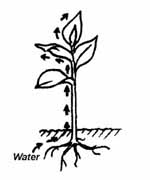
|
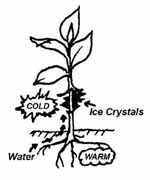
|
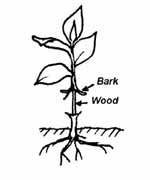
|
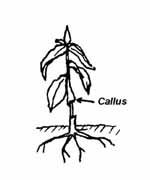
| |
1. In a rooted cutting that is not dormant, moisture in the soil is being pumped from the roots up into the leaves. Food made in the leaves will return to feed the roots.
|
2. If cold weather hits the top but the roots are still warm, water continues to flow upward but will freeze just under the bark, splitting tissue away from the stem.
|
3. After the ice melts, the bark is still separated from the wood. Unless that bark is able to heal, the cutting is now girdled and the plant will eventually die.
|
4. Since live bark does not connect the leaves to the roots, the cutting wilts and dies later that year. Callus tissue forms at the site of the wound where it tried to heal.
|
Raising Rhododendrons and Azaleas from Seed
by Don Hyatt
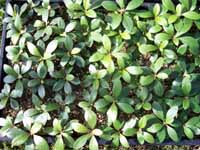
Since much of this newsletter contains the chapter seed exchange, I thought it would be appropriate to include a refresher on how to raise rhododendrons and azaleas from seed. Some of you may not have tried to raise any plants from seed yet, and we need to remedy that. Here is the Don Hyatt Procedure, which has been very successful for me. I am convinced that raising plants from seed is one of the most rewarding aspects of gardening. Rhododendrons can bloom in 3 to 4 years from seed, azaleas even sooner.
- Container – Any clean pot will do. The only requirement is that I must find a clear plastic bag that will cover that pot and leave a bit of headroom for seedlings to grow inside.
- Plastic Bags - I use clear plastic bags to create a mini-greenhouse. It will keep the humidity high inside while the seedlings grow during the winter months. I will not have to do much of anything for all winter long but watch them grow. Should small seedlings dry out just once, they usually die. This method means they will succeed on their own in spite of my tendency to neglect my plants.
- Medium – I use my standard rhododendron medium: equal parts peat moss, sand, and perlite. The medium should be moist but not wet. Sand is not required, but I like the weight and texture it provides. If you use sand, make certain you avoid forms that have any lime or salt content since that can be toxic to rhododendrons and azaleas.
- Planting - Sprinkle the seeds over the top of the medium. Do not cover them with soil, but place the entire pot inside the clear plastic bag to create that mini-greenhouse. You may mist the seed lightly with water but the 100% humidity inside is usually enough moisture to initiate germination.
- Light – Rhododendrons and azaleas do require adequate light to grow well. I use inexpensive “Shop Lights”, fixtures with two fluorescent tubes that I suspend about 12 inches above the containers. The lights can be plugged into a timer that keeps them on for at least 16 to 24 hours a day. Another option is to set the containers on a bright north or east windowsill that doesn't get too much direct sun since heat can build up inside.
- Care - Seeds should germinate in 3 to 4 weeks. In most cases they will require no additional care until spring when seedlings can be transplanted into flats or individual pots. The condensation on the bag usually falls back into the pot so there is no need to water. If the medium was damp to begin with, it usually remains damp unless there was a hole in the bag. Avoid fertilizer when the plants are under low light conditions since seedlings are more prone to disease problems.
- Transplanting – If seedlings are too close, I will transplant crowded pots to space plants an inch or so apart in new containers. I then put them back in bags under the lights. After the weather is warm, the plants can go outside. I often transplant at that time into larger flats or community pots, spacing seedlings about 1½ to 2 inches apart. The flats can be set outside in some bright area that has open shade, such as the north side of the house or beside some larger plant and grow on their own all summer. I do cover flats with netting or screening to keep critters from digging in the soil. Mike Creel sows his seeds directly outside in sunken pots covered with screen and get excellent results.
- Problems – Potting soil that is too wet is a major cause of problems with seedlings. A gray mold can develop on seedlings inside the plastic bags, especially if they are planted too close together. Opening the bags, picking out the mold by hand, and letting things dry out will often help. I prefer to transplant any seedlings with mold into pots with fresh medium and I make sure leaves do not touch. I then watch carefully for further mold.
- Extended Care – I let natural selection eliminate the weaker plants so one way to test for hardiness is to leave the seedlings outside that first winter. I mulch flats well after cold arrives, but realize many will perish by spring. I transplant whatever is left into gallon pots, and then wait for blooms.
I want to thank the many people who have provided us exciting new seed sources this year.
Vijay Chandhok from Pennsylvania collected some seed from rhododendrons at 11,000 ft. in the northern India in the Himalayas near Pindar and Kafni Glaciers. Ken Cox feels the plant is the pink to white species, R. campanulatum, which has attractive blue-green foliage.
Mike Creel, from South Carolina has sent us some great things including seed from Galle’s ‘Choice Cream’, which will likely be an F2 since every flower sets a seedpod. That hybrid was a cross of two fragrant native azaleas: R. austrinum, which is a tall yellow, and R. atlanticum which is a low white with blue-green foliage. The next generation should give lots of great plants.
For the first time, we have seed of alabamense (op) sent by Doug Chapman in Alabama. We also have seed and crosses of two late blooming forms of arborescens that open in July and August. One is the variety ‘georgiana’ thanks to Jim Gears, and the other is ‘Judd’s Arb’ from Mike Creel.
Jim Gears also sent us seed of some superior forms of R. flammeum from the Adcock garden in Georgia and R. prinophyllum from Dolly Sods.
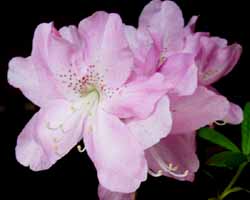
The Fellers from New York sent us seed from their gorgeous R. schlippenbachii that won Best in Show at the Middle Atlantic Chapter ARS meeting in Gloucester this spring (pictured left). The flowers were the best I had seen... large, flat, well formed, and a clear, strong pink.
We have lots of R. calendulaceum seed this year. I went on several trips this fall and gathered seed from a number of excellent forms. One area near Big Yellow Mountain (abbreviated BYM) in Avery Co, NC, has a plant that Jim Gears and Karel Bernady call Jacob’s Coat. Its flowers are both yellow and orange-red. I collected seed from other selections near BYM including a large red. There are other selections including the large flowered forms at Hooper Bald (HB), and favorite plants at Jane Bald (JB) and Engine Gap (EG).
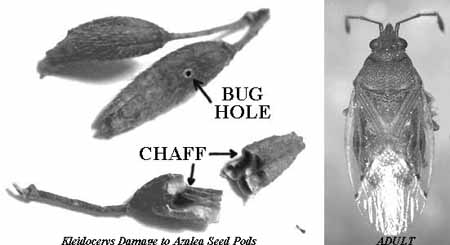
I was very disappointed with a number of hand-pollinated crosses I made with native azaleas this year. I had many large seedpods coming along but as they were drying out this fall, I noticed a small hole in almost every one. When I cracked the pods open, there were no seeds inside but just some dark brown chaff, like fine dust. Apparently the larva of a small insect only ¼ inch long known as Kleidocerys resedae (pictured right) was the culprit. It doesn’t harm the plants but ruined 95% of the crosses I made this year.
I did salvage a few seeds from some successful crosses I made this year with my fragrant tropical rhododendron, R. veitchianum. I have been trying to hybridize with that plant for at least 20 years, and this time I had success by crossing onto potted plants I brought into my kitchen where I kept them very warm while I made the cross. There are not many seeds unfortunately, but I will try again.
In the hybrid rhododendron section, we do have some great hand pollinated crosses. Norman and Jean Beaudry sent us crosses with Hardy Giant as well as my form of R. metternichii, the nicest foliage plant in my garden. I made some crosses onto Hachmann’s red and white yakushimanum hybrid, ‘Fantastica’.
In open pollinated (op) species, Bob King sent us seed collected from his R. yakushimanum plants and we still have seed from his metternichii. Jane Goodrich sent (op) seed from some Gables and her almost orange (CatFortCampy x Mary Garrison).
In the evergreen azaleas, I used ‘Satcherstern’, a red-bordered florist azalea in some crosses, as well as Joe Klimovicz’s double pinks, ‘Caitlin Marie’ and ‘Lovely Linda’. With open pollinated seeds, whenever possible I tried to list the closest plant nearby that might likely be the other parent.
On several crosses, seeds were very scarce, only enough for one or two small packages. I listed those on the order form and will use them for bonus packages or substitutions.
Link to the 2005 Seed Exchange
|